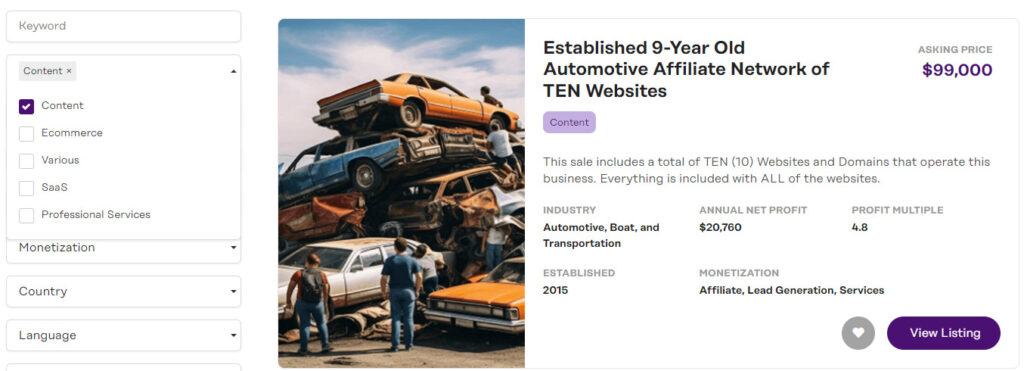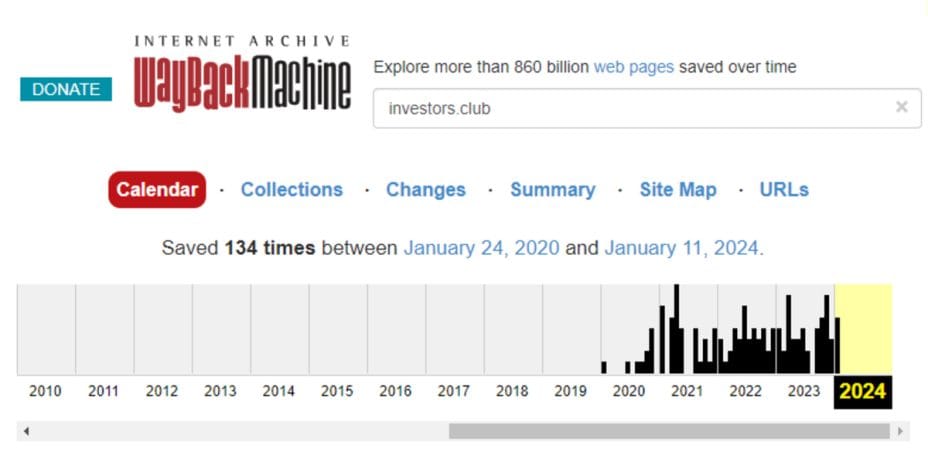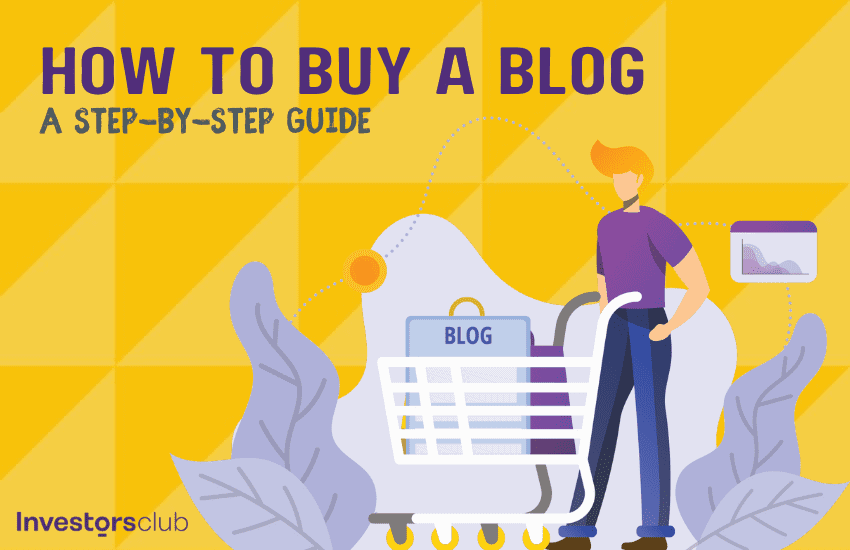Blogs and content-based websites are among the most popular online business models for acquisitions. Whether you’re an individual investor or represent a large company, if you’ve considered purchasing a website or online business, a blog is an excellent choice.
This article covers all the essential details about how to buy a blog or content website, with each step explained so you can start your blogging journey today.
Is a Blog Still a Valuable Asset?
With the rise of video content and social media platforms, some investors question the value of a blog in today’s world. The truth is that successful blogs and content sites are still very valuable assets, and that’s unlikely to change in the foreseeable future.
Looking to buy an established blog? At Investors Club, you can find many quality blogs for sale. We also have a lot of passive income businesses for sale, and many of them happen to be blogs.
Here are a few reasons why so many companies and individuals consider blogs and content sites such good investments.
Low Costs to Operate
Blogs and content websites have low operating costs compared to other types of businesses. Content creation is the biggest expense for most sites, usually from freelance writers or content agencies, but blog owners can control content costs. Overall, profit margins for successful blogs are typically very high.
Passive Income Potential
Established blogs can run with minimal maintenance or work from the business owner. Those who seek passive income can outsource most or all of the work. Writers, editors, and virtual assistants (VAs) can handle most essential tasks.
No Inventory
Unlike an e-commerce business, blogs and content sites don’t require inventory management. You’ll have no need for warehouses, shipping, receiving, returns, or other issues related to physical products.
Potential for Scalability
Blogs with a strong brand and a dedicated audience have excellent potential to scale and grow quickly. Profits may rise significantly by increasing blog content production, growing a social media following, or building a strong email list. Blogs can also expand into other content forms like podcasts and YouTube channels.
Diversified Income
Blogging can make money in numerous ways. Display advertising revenue, affiliate marketing, and digital products are just a few examples. A high-quality blog can also help drive traffic to, and increase conversions for, your other products and services. Adding new revenue streams can quickly increase profit and the blog’s value.
Long-Term Income Potential
A well-established blog may continue to generate income for years. Each piece of evergreen content that’s published has a chance to generate revenue every month. Older, well-performing content can often be easily refreshed, helping it continue to be profitable. As the blog and its audience continue to grow, income may also grow.
Ideal for Portfolio Owners
Blogs and content sites are ideal for those wanting an income-generating online business portfolio. If you’ve succeeded with one blog, you can often replicate the same approach with another.
Can Be Sold Later for a Profit
A well-established and profitable blog or content site is a valuable asset you can sell when you’re ready to move on. Whether you purchase the blog or build it from scratch, a future exit offers significant potential.
How to Buy a Blog or Content Website
Now that we’ve discussed why you might consider buying a blog, let’s dive into the steps of the acquisition.
Step 1: Determine Your Budget
As with any investment, you need to determine how much you’re willing to spend. Consider your financial goals and risk tolerance when setting your budget.
Thankfully, you don’t need a massive budget to buy an established blog. At Investors Club, our listings start as low as a few thousand dollars. Most of the blogs and content sites we list are priced between $5,000 – $20,000, and generate $300 – $700 monthly profit, so you can hit the ground running even without spending hundreds of thousands of dollars.
Of course, you’ll have even more options if you have a larger budget.
Step 2: Research Blogs for Sale
Once you know your budget, it’s time to start researching blogs for sale. Create a buyer account and browse the Investors Club listings. You can use the filter to show all the content site listings.

You can also sort the listings by price or date listed.
Our listings provide plenty of details, like:
- Business summary
- Business history
- Assets included in the sale
- Financials
- Traffic details
- Website metrics
- Tech stack
- Search engine optimization (SEO) risks
Step 3: Select a Few Candidates
As you browse through the listings, note any that interest you. The next step is due diligence, but for now, you’re just looking for blogs to evaluate further.
Consider things like the blogging niche (does it interest you?) and asking price (does it fit your budget?) to find a few blogs or sites worth evaluating.
Step 4: Evaluate Each Blog You’re Considering (Due Diligence)
Now it’s time to dig into the details. Due diligence is a crucial step in buying a blog or content website. At this stage, look for red flags that might indicate the blog isn’t a sound investment. Also evaluate the opportunities for growth that indicate potential for a positive return on investment (ROI).
At Investors Club, you can contact the seller with a specific question, and premium members get reports including:
- SEO analysis
- Content analysis
- Traffic analysis
Here’s a quick look at some things to consider.
Domain Name and Website History
Use Whois to check the domain name’s registration history. This shows when the domain was first registered and last updated, and the registrant’s details. Many domain names use private registration, which hides the owner’s details. But if private registration isn’t used, you should verify that the listed owner matches the person selling the blog.
The “updated date” shows the last time details of the domain were changed, which could indicate it was sold or transferred to a new owner. If the updated date is recent (within the past few months), ask the seller why it’s being listed for sale again so soon.
You can also use the Wayback Machine at archive.org to check past site versions and see if there have been significant changes. Of course, the look and feel of the site will change over time, but if the site currently focuses on dog grooming and used to be about auto repair, that’s a red flag. Ideally, you want to see that the site has covered the same main topic and naturally evolved over the years.

Business Operations
You’ll want to understand the basic operations of the website and how the business runs. The seller interview we provide is an excellent resource for these details.
Consider things like:
- The number of hours the owner works on the blog
- The specific tasks involved in running the blog
- The monetization methods
- The freelancers (if any) that are in place
- The types of content published
- The traffic generation methods
Make sure you understand the basics of how the business operates and what’s involved with running it. Of course, you can and likely will make changes, but it’s helpful to understand how the business currently operates before making major adjustments.
Niche or Topic
The blog’s niche or topic is an essential consideration in its potential for success. Be sure to think about:
- The size of the potential audience
- Room for growth
- Opportunities to expand into related topics
- Upcoming trends that could impact the niche
- Evergreen vs. trendy (is the niche timeless?)
- Monetization methods of other blogs in the niche
Ideally, you want a blogging topic with a large, engaged audience and room for growth. You also want a niche that offers multiple monetization options so you can have diversified income streams. You’ll want to avoid niches that might lose popularity or fall out of favor.
Of course, you should also consider your personal interests and experience. Does the topic of the blog interest you? Is it something you would enjoy working on? Does it match your experience, or are you willing to learn more about the topic?
Content Quality and Quantity
Content is the heart of any blog or content site, so evaluating the quality and quantity is essential. Look through the site and read a few articles to get a feel for the writing style and overall tone. Consider:
- How often is new blog content published?
- Will you be able to maintain the same blogging frequency?
- Are the articles well-written?
- Are there evergreen pieces (blog posts that are always relevant)?
- Are there any standout posts that are particularly popular or well-written?
- Are the photos, graphics, and other media high quality?
- Does the site have a consistent voice or tone from one blog post to the next?
Also, take time to look at other blogs covering the same topics. How does the content compare to competitors?
Traffic and Revenue Trends
Are the site’s traffic and revenue increasing, decreasing, or steady? Remember that some topics are seasonal, so looking at year-over-year trends is helpful. For example, a gardening blog will likely experience decreasing traffic and revenue in the winter. That’s not necessarily a bad sign.
If you’re considering buying a blog with declining year-over-year traffic and revenue, you’ll need to reverse those trends to realize a positive ROI. Can you identify the cause of the negative trends and what you can do to turn things around?
Trends can also impact the price you’re willing to pay. The multiple should be lower for sites with significant downward trends, and you may be willing to pay a higher multiple for growing sites with steady upward trends.
Investors Club premium members see helpful charts that display the site’s traffic (details come from Google Analytics) and revenue trends.
Traffic and Revenue Diversity
Is the blog dependent on a single source of traffic or revenue? If so, it presents a greater risk. If something happens to that traffic or revenue, it will likely impact profitability.
Ideally, to decrease your risk, you’ll want to find a blog with several traffic sources. If the site makes all its money through affiliate programs, you’ll want to see that it has revenue from several different programs rather than a heavy concentration on one affiliate program.
Inbound Links
Links from other websites are important for SEO since they’re a major factor in search rankings. You can use tools like Ahrefs or Semrush to inspect the blog’s link profile to see all of the other sites and pages linking to the blog, and whether they’re quality backlinks or spam. If you’re not sure how to do this, Ahrefs offers a helpful guide.
Competition
You need to understand the competitive landscape as well. Take some time to research and survey the competition within the same niche or topic. Look at competitors’ monetization methods, traffic sources, content quality, and overall business strategy.
Understanding your competitors can help you identify areas for improvement as well as how your blog will fit into the market. You’ll also want to know if you’ll have to compete with any big players in the industry.
Identify Growth Potential
In addition to evaluating the current state of the blog, you’ll want to identify areas for growth and improvement. Can you increase traffic by updating the types of content or increasing the blogging frequency? Can you use other social platforms to reach your target audience? Can you increase traffic by doing keyword research and creating better optimized content?
Of course, increasing profit is the most common goal. Are there additional monetization methods you can implement? Are there ways to improve the revenue of the current monetization methods?
You should consider the financial cost and time requirements of any potential changes. Will the outcome justify the time and money?
Ask Questions
Be sure to contact the seller with any questions you have. At Investors Club, we facilitate communication between buyers and selling, making it easy. Simply use the “request information” form on a listing to get in touch with the seller.

Even if you don’t have any specific questions, contacting the seller is helpful because it allows you to interact with them. Positive interaction helps the buyer to be familiar with you before they receive your offer.
Step 5: Make an Offer
Once you’ve decided which blog to buy, it’s time to make an offer. Message the seller to present your offer, which they can accept, reject, or counter.
Step 6: Complete the Acquisition
After you’ve come to an agreement with the seller, it’s time to complete the sale. You’ll need an asset purchase agreement (APA), the legally binding contract signed by the buyer and seller.
An escrow service for the payment protects both buyer and seller, and is recommended. As the buyer, you’ll transfer the money into an escrow account. The escrow agent will release the funds to the seller after everything has been transferred.
Step 7: Complete the Transfer
Finally, you’ll need to change ownership of the domain name and have the seller transfer the assets to you. This may involve moving the website to your own hosting account, or the seller may be able to simply transfer their existing hosting account to you so the site won’t need to be moved.
Frequently Asked Questions
Is it a good idea to buy a blog?
Yes, buying a blog can be a profitable and worthwhile investment. However, losing money on this type of digital asset, just like any other investment, is also possible. You should thoroughly research the blog before making an offer to ensure it aligns with your goals and interests.
Are blogs still profitable?
Yes, blogs can still be profitable and are a legit online business opportunity. In fact, today’s monetization options are better than what was available several years ago. There are countless ad networks, affiliate networks, and influencer platforms for monetizing your blog. You can also sell products, create online courses, or offer a membership community. The potential return on investment (ROI) is significantly higher than most other types of investments.
How much does it cost to buy a blog?
The cost of buying an existing blog varies based on factors like revenue, traffic, age, niche, and social following. Investors Club listings range from $5,000 to more than $1 million.
Which blog niche makes the most money?
No one specific niche guarantees the most profit for a successful blog. It ultimately depends on the quality of content, growth strategies, and monetization methods implemented by the blog owner. However, some popular and profitable niches include personal finance, health and wellness, beauty and fashion, technology, and lifestyle.
You should research different niches and choose one that aligns with your interests and has growth potential. If you choose a popular and competitive blogging niche, creating high-quality content is critical.
Where can I buy a blog?
We add new listings at Investors Club each week. Blogs and content websites typically account for more than half our listings, so there’s plenty of selection. You can see all online businesses currently available for sale.
How to Simplify the Process of Buying a Blog
Buying an established blog or content website can be a great opportunity, but it requires careful consideration and due diligence. From understanding the blog’s traffic sources to assessing the competition, identifying growth potential, and making an informed offer, each step is crucial to increase your chances of a profitable acquisition.
Whether you’re looking to diversify your income streams, have a passion for a particular topic, or see untapped potential in a blog, the decision to buy should always be backed by thorough research and planning.
Investors Club helps buyers by making it easy to filter listings and communicate with sellers. Create your account today and browse the current listings.

Online Business Builder & Content Strategist
Marc has been building websites and online businesses since 2007. He’s built successful businesses in several industries, including web/graphic design, photography, travel, and personal finance. Marc is the founder of Flip My Site, where he writes about buying and selling websites.
Connect with Marc:
Linkedin | Twitter | FlipMySite

